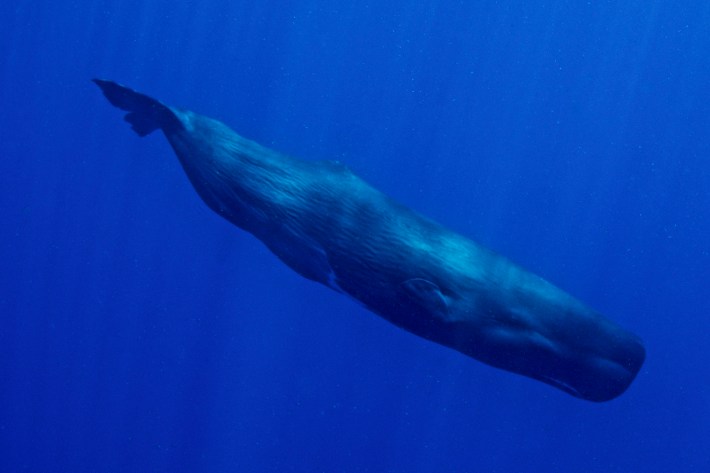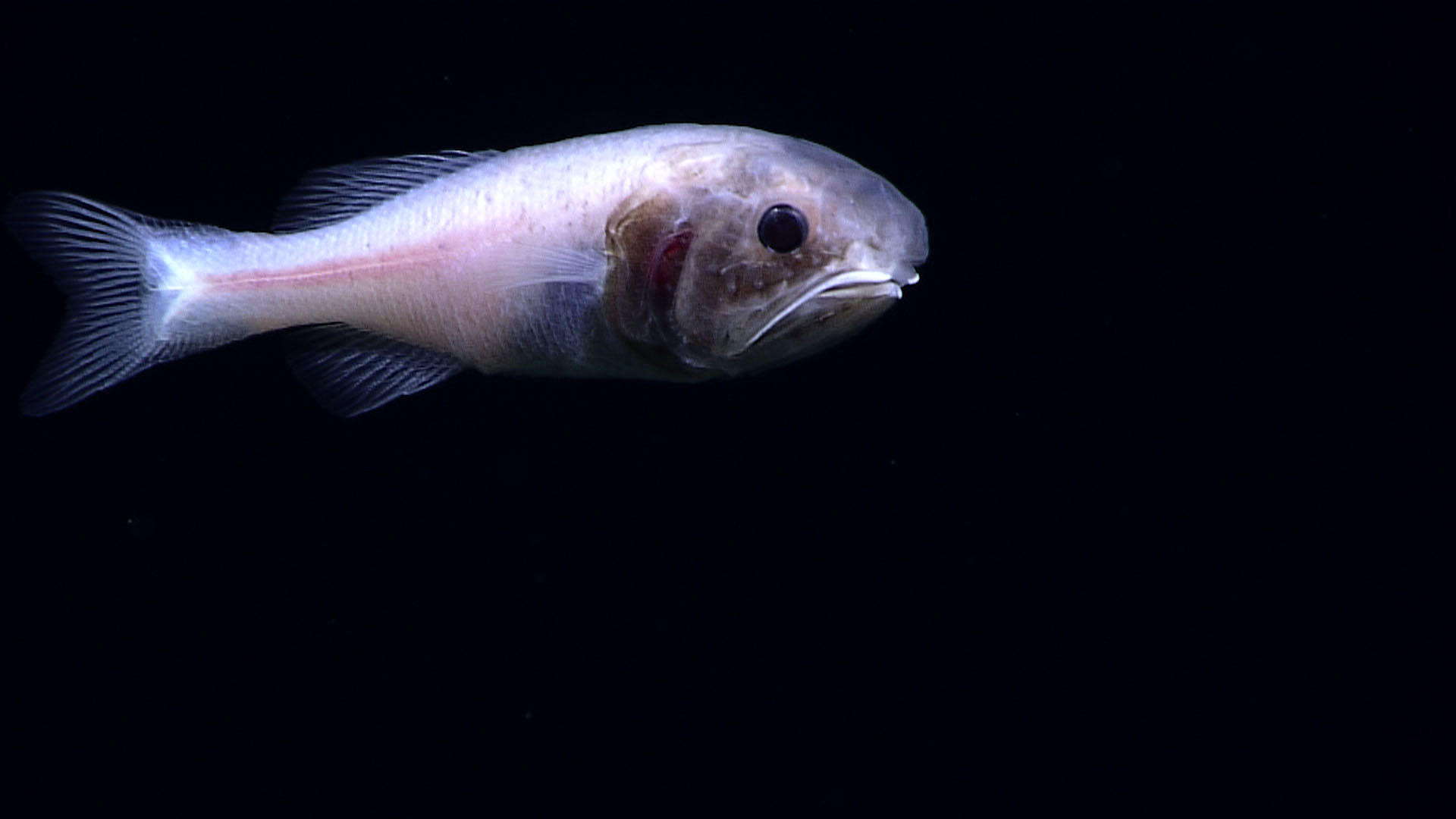Off Japan's Minamitorishima Island around twilight, after the sun has dipped below the horizon, the sounds of many animals join together in a choir. They cannot be heard on land, for the participants in this choir are fish. They do not sing with vocal cords—they do not have any—but rather by contracting their gas-filled swim bladders to buzz like a kazoo or by rubbing their fins or teeth to chirp like a cricket. The overlapping calls of all these grunts, buzzes, burbles, and squawks coalesce into a chorus that peals across the vast ocean in distances that would disappear sunbeams.
"Light doesn't travel well in sea water, and so it is pitch dark at great depths," Christine Erbe, the director of the Centre for Marine Science and Technology at Curtin University in Perth, wrote in an email. "But sound travels extremely well."
The carols of the fish chorus travel too, not just across the waves but beneath them. They form part of the ocean's soundscape, which comprises all the noises made by animals, natural forces like wind and earthquakes, and man-made technology. Different ocean ecosystems have different soundscapes, and Tzu-Hao Lin, a researcher who self-describes as an "ocean listener" at Academia Sinica in Taiwan, has devoted himself to studying the particular acoustic atmospheres of the deep sea. He has recorded soundscapes from hydrothermal vents, the twilight zone, and abyssal plains more than 18,000 feet deep in waters by the remote island of Minamitorishima. In these exceptionally deep waters, Lin thought he'd detected a chorus of fish singing soon after sunset and quieting at midnight. But the recording was so brief, representing less than a day in the deep, that it might have been a blip, a passing school of chatty fish.
"It's in the deep sea, you know, so we actually don't have many scientific questions in the beginning," Lin said. "We just want to explore what we will be able to discover."
Lin came up with a plan to record the sounds of a deep-sea abyss for an entire year. In March of 2020, Shinsuke Kawagucci, a researcher at the Japan Agency for Marine-Earth Science and Technology, dropped an underwater recording device called a hydrophone off the side of a ship south of Minamitorishima, which is off-limits to civilians and isolated from shipping traffic. The hydrophone sank until it settled on the seafloor, 18,000 feet below. It sat there for a year, in an area too deep and remote to be photographed, recording for two minutes every four hours. When the researchers retrieved the device the following April—remotely triggering it to unlatch its anchor and ascend more than three miles to the surface—they recovered a year-long record of the soundscape of the abyss, which Lin and Kawagucci published in the journal Limnology and Oceanography last fall.

Back in the lab, Lin pored over the 4,260 minutes of recordings. Oceanic soundscapes often don't sound like much to the human ear. "It's just like the white noise emitted from some kind of broken TV," Lin said. A better way to understand these sounds is, paradoxically enough, to see them. Lin ran a computer program that spawns spectrograms that visualize the audio data, revealing the changes in frequency and intensity over time (here is a good example of a soundscape and its associated spectrogram).
The data revealed that, by day, the Minamitorishima abyss was a quiet place, interrupted occasionally by whistles and clicks from passing marine mammals or the engines of faraway ships. But the abyss crackled to life each night, resounding with a chorus of fish during sunset and quieting at midnight. Even Lin, a mere human, could hear a "huge difference" between the sounds of day and night, he said. He was taken aback. His prior data hadn't just been a blip. This first chorus could be heard each day from 8 p.m. to midnight between May and September. From December to June, a second chorus sounded, also around 8 p.m.
At a glance, this discovery might seem unremarkable. The ocean, after all, is full of fish. But the timing of these fish choruses—both materializing around twilight—meant that different times of day in the abyss were characterized by different sounds. The researchers consulted previous studies and found similar evening choruses could be heard across swaths of the Pacific and Indian Oceans at depths of nearly 1,000 feet to more than 18,000 feet. The researchers wondered if these sounds were tied to diel migration, the daily phenomenon in which billions and billions of plankton, fish, and other animals rise toward the ocean's surface at night and sink back into deeper seas at dawn. If the singing fish were migrating along this vertical path, they might descend to depths where their voices become perceptible to the abyss around sunset. In other words, while deep-sea creatures might not see the sunset, they might be able to hear it.

As creatures of the sun, we keep time with circadian rhythms—our internal clocks that oscillate in 24-hour cycles in response to light and darkness. Scientists long assumed the deep sea, a realm removed from the cycles of sunlight and darkness that dictate much of life on Earth, had no such rhythms. But as the technology of deep-sea exploration has improved, allowing scientists to record abyssal environments for longer periods of time, they have discovered deep-sea daily rhythms that might be explained by biological clocks. For example, in the shimmering waters of hydrothermal vents more then 5,500 feet deep, Bathymodiolus thermophilus mussels obey 24-hour rhythms.
Hans van Haren, an experimental physicist and physical oceanographer at the Royal Netherlands Institute for Sea Research who was not involved with the research, has observed deep-sea plankton engaging in daily vertical migration at depths where it is impossible to detect shifts in sunlight. The plankton cluster by day and scatter closer to the surface at night, and these movements were actually initiated by the deepest-dwelling plankton groups. So if sunlight was not a cue, perhaps the trigger resided somewhere inside the plankton. "Our main hypothesis was control by stable biological clocks, although we considered the possibility of acoustic noise," van Haren said, adding that the soundscapes revealed in the new paper still do not explain how the deepest plankton groups lead these migrations.
But our internal clocks are not entirely biological. They are also synchronized by environmental cues called, charmingly, zeitgebers—derived from the German word for time givers. The new paper suggests the sound of migrating species from above could be a zeitgeber that allows many deep-sea species, with or without a biological clock, to tell time. The identity of these migrating species, however, remains a mystery, as Lin and Kawagucci could not identify any individual species within the evening choruses. But the precise implications of these sounds for other species remains an open question. "It seems strange that species would betray themselves to their predators by making noise," van Haren said.
Although there is a paucity of research actually testing the hearing and noise-making capabilities of deep-sea fish, the anatomy of many species seems attuned to hearing, with outsized ears or inner ear structures with special adaptations. "We know so little (too little) about deep-sea creatures, but given the lack of light, it is plausible that many of these species use sound to sense their environment, navigate and communicate," said Erbe, who was not involved with the research. Given the daily patterns of sounds wafting down from fish, marine mammals, and other animals closer to the surface, "it would be no surprise if deep-sea, benthic creatures responded to that, or evolved to utilize these sounds from higher up in the water column," she said.

Lin and Kawagucci's recording also picked up occasional whistles and echolocating clicks from passing marine mammals, which they suggested could mean the area may be a foraging ground for sperm whales and beaked whales. Erbe pointed out that certain species of fish and mammals produce feeding calls as they follow prey, which may be migrating vertically, so a whale's song or dolphin's whistle will exhibit these daily patterns, she said. Given the fast speed of sound in the ocean, these calls will travel quickly to the depths "where they might induce rhythmic patterns with the same 24-hour period," Erbe said.
Lin acknowledges the new data is rather limited, sampled with a single hydrophone at sparse intervals in the day. He'd like to return to take higher-quality recordings. Erbe suggested using technology that could indicate the source of the sound, as the presence of sound at great depths does not necessarily indicate the sounds are also coming from great depths. "Once we can locate the source, we might have a much better idea which animal or species makes the sounds we hear at depth, and ultimately the function of those sounds," she said.
The abyssal plains by Minamitorishima prickle with manganese nodules, which contain rare minerals coveted by impending plans for deep-sea mining. Like any other kind of mining, deep-sea mining will be a noisy business, conjuring sounds from the operations as well as surrounding ships. This pollution would overwhelm the local soundscape, drowning out any distant twilight choirs, dolphin clicks, and whale songs. For deep-sea creatures that can sense these sounds, this might be like blotting out the sun. But more research is needed to understand the role of sound in the deep-sea—and how consequential its muffling might be.
"When we talk about deep sea mining, we really need to be careful about how this kind of noise impacts the deep-sea ecosystems," Lin said. "We know still very little."






